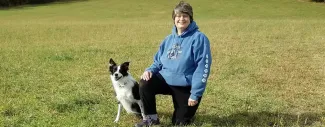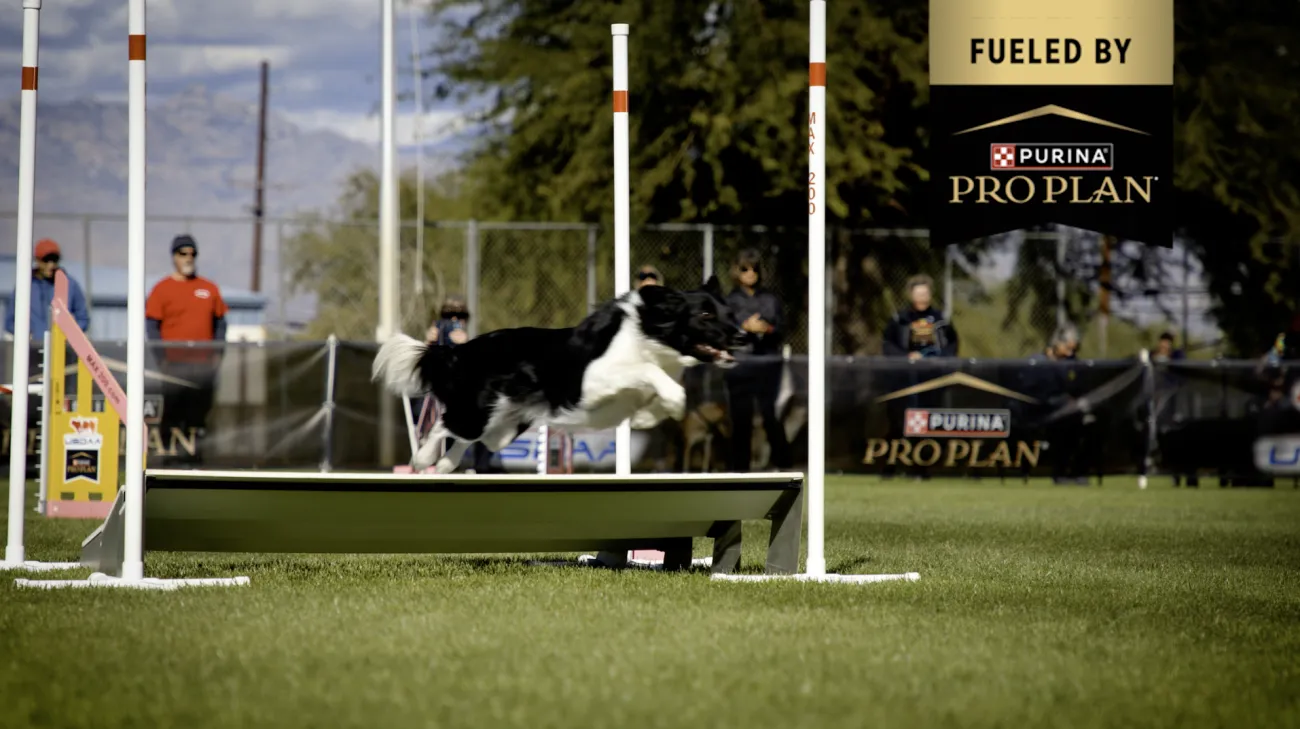As Janet Gauntt of Columbia, Maryland takes the helm as manager of Team USA for the United States Dog Agility Association® (USDAA) on its journey to the 2025 International Federation of Cynological Sports (IFCS) World Agility Championships (WAC), she can’t help but feel a sense of déjà vu.
This year’s WAC, which will be held June 16 to 22 in Givrins, Switzerland, marks her return to the country where she discovered agility 37 years ago while working on assignment as a software engineer. Not her first WAC, Janet was coach of Team USA in 2006 in the Netherlands and manager of Team USA in 2008 in Belgium.
“At its highest levels, agility is a game of inches and fractions,” Janet says. “You can win a competition, a spot on the podium, by hundredths of a second, which translates to perhaps a foot shorter on the dog path, the tightness of the reaction time between the dog and handler or that fraction of an inch difference between hitting the contact zone or clearing a bar on a hurdle.
“It is quite a thrilling sport. Even though the actual run is under one minute, it’s a very intense minute. Handlers are pushing themselves physically as well as their dogs, and they both come off a run very high.”
The performance-driven nature of the sport is tethered to the “deep training relationship handlers have with their dogs,” she says.
Performance, training and relationship will certainly come into play at WAC, one of the toughest agility competitions in the world. More than 200 handler-dog teams from 14 countries are expected to attend, including Russia and Australia, who have been absent in recent years. All aim to earn a spot on the podium and bring home medals.
Team USA will feature 18 handler-dog competitors who were chosen by a committee headed by Janet Gauntt and Ken Tatsch, founder and president of USDAA, based on their online applications and video submissions. Four teams who earned nine medals in 2024 are returning. Nearly all the handlers have accrued experience at previous WAC events, though five dogs and one handler will make their IFCS debut.
Their manager describes herself as “a competitor, instructor and judge.”
Modesty aside, Janet is the recipient of USDAA’s highest honor, the Pioneer of Dog Agility award, and the subsequent induction into the USDAA Hall of Fame. She was recognized in 2014 for her trailblazing and meritorious service.
A checklist of Janet’s accomplishments reflects the breadth of her contributions. Over many years, she and other board members worked to develop and fine-tune USDAA’s titling programs and tournament system, and she proposed the Masters ChallengeSM program that began in 2013 to bring even more variety to course designs in USDAA. Today, it is featured in the Masters Challenge BiathlonSM tournament series, one of four USDAA major tournaments.
Janet is the lead author of the USDAA Course Design Guidelines and was an early contributor to USDAA and mentor to several USDAA training organizations and judges. Importantly, she is known for constantly looking for ways to improve the sport and provide opportunities for handlers with both domestic and international goals.
“Janet’s past experience at WAC, as both coach and manager, combined with her persistent studious nature give her a unique perspective,” Ken says. “Keeping team members focused on the task at hand is the biggest challenge for team leadership. Janet has what it takes to lead the team to success.”
Among her strengths, Janet is keenly perceptive of what it takes to manage a top-level team at an international venue. Her forte is settling nerves and setting strategy.
“The largest challenge is the stress of travel,” Janet concedes. “There’s a big difference between loading your dog on a plane, traveling up to 14 hours and dealing with unknown logistics versus somebody else who had a six- to eight-hour drive in their car to get there.
“My job is to help Team USA relax and get into their performance groove. I want to make sure the competitors are in the comfort zone that works for them. I want them to have the chance to practice on some local equipment, breathe the local air and begin to feel like they belong there.”
USDAA Plays Role in IFCS Beginning
When Ken founded USDAA in 1986, bringing the sport of dog agility to the U.S., it was modeled after the British method introduced by Peter Lewis, one of the founders of the sport. Ken had studied under Lewis and wanted to promote international standards for dog agility in the U.S. At the same time, Lewis was actively promoting the sport throughout Europe.
Years later, Ken was a lead in the effort spearheaded by Russian Yuri Ostashenko, a dog enthusiast and manager in the Russian Ministry of Sport, to organize a platform for international competition. Modeled after the Olympics, the collaboration that became IFCS effectively removed breed and personal biases. Rather, it focused on making dog agility a respected global sport.
Ken’s leadership in developing and promoting IFCS on behalf of USDAA is noteworthy. He was among the representatives of several countries who signed the Declaration of Support of Concept for IFCS in February 2000 in Moscow. He was asked to serve as a governing council member and IFCS vice president, and then worked with Ostashenko to organize the first IFCS WAC in April 2002 in Moscow, where he served as chief judge. He collaborated on drafting the IFCS regulations for dog agility which helped to broaden the IFCS competition program where the USDAA influence can be seen to this day. Since 2006, he has been an IFCS officer, serving as president from 2006 to 2012, and then as secretary general since being elected to the IFCS Congress in 2012.
Accounting for her idea to introduce courses with a European flair to USDAA via the Masters Challenge, Janet says, “European agility evolved to have large, long, narrow rings. These courses were very different from the skills that we and the British people had honed, as the template of a ring influences its design and challenges.
“We began taking the challenges they had developed to fit those long, narrow rings – things like backside jumps and tunnels under objects – and incorporating them into our course designs. Before this, our judges were not designing them into our courses because our rings were nice and large, and the dogs always moved forward.”
Among competitors’ favorites on IFCS courses are the strategic games of Gamblers and Snooker, which are also part of USDAA events.
“IFCS has a strong emphasis on the games classes,” says Janet, noting how skills that are developed and strengthened from games can help improve a dog’s performance in Standard Jumpers and Agility.
“Gamblers is essentially a distance challenge where the handler must separate from the dog while sending the dog a long distance over a line the handler cannot cross,” Janet explains.
“In Gamblers, if you can accurately predict the dog’s performance rate at certain obstacles, you can monitor and constantly improve your dog’s performance,” she says.
“This is a necessary skill to getting better in the sport. A handler can get a significantly faster dog performance when running Standard Agility or Jumpers courses if they break the dog loose at strategic points from their handler’s much slower speed and reaction time.”
“In contrast, Snooker alternates between a dog focusing closely on the handler and working independently with obstacle focus, which applies directly to segments of an Individual Standard or Jumpers course,” she says.
Looking back 37 years, Janet sees herself starting out in agility in Switzerland. Little did she know then that the sport would become such an important part of her life.
Touching on her goals for Team USA, Janet says, “Obviously, we want to get as many podium placements as we can. This is what we are going for.”
Ken agrees.
“We have high hopes for Team USA in Switzerland,” he says. “Each year, the competition gets more challenging, but we believe we have built a strong team that has the talent, skills and grit to win.”
Good luck, Janet and Team USA!

